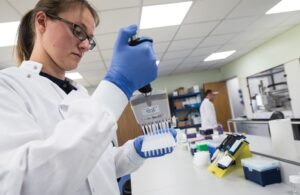
As pet food and human food are intimately related, I subscribe to and read several newsletters regarding human nutrition. Reading Coco Liu’s recent article on Bloomberg.com about an emerging alternative protein source, one offhand sentence caught my eye: “The company plans on selling its powder as a protein booster to factories manufacturing aquatic feed and pet fare, before branching out further with human-grade foods.
MicroHarvest, which has created the powder, is developing a way to take one, unidentified bacteria and ferment it into a protein that “tastes like a mix between miso paste and Vegemite (a spread made from brewer’s yeast popular in Australia),” wrote Liu. I tend to enjoy trying out new flavors and textures but this doesn’t sound particularly delicious.
MicroHarvest plans to introduce it first into aquafeed and pet food as a “protein booster”, though the article doesn’t specify. (No doubt this would require extensive research or discovery work by MicroHarvest in order to ascertain its nutritional benefits or determine any regulatory considerations (likely quite complex.))
However, this development demonstrates how people and animals alike are seeking alternative protein sources – one which will likely have lasting ramifications on the pet food industry.
Alternative proteins present their own set of challenges In her Bloomberg article, Liu compares MicroHarvest’s protein products and similar microbe-based or fermented ones with plant-based and cell-grown meat options, such as plant-based proteins and cell-grown meat. Fermented protein may have an edge over its alt-protein rivals: while it still may not replicate conventional steak in texture, taste and appearance, turning a teaspoon of bacteria into ready-for-consumption protein powder takes no more than 24 hours.” By contrast, growing soybeans or peas used for plant-based mince or burger offerings takes weeks.
As with other innovative alternative proteins, insect protein faces some of the same difficulties, particularly scalability issues. Even its industry has yet to reach a level that makes it cost-effective and widely accessible enough for widespread replacement as an affordable source of protein.
However, while insect protein sources like insects may boast their sustainability credentials, that remains uncertain when applied to other alternatives such as cell-based meat. Recent studies have demonstrated this fact by showing the energy required to grow and cultivate cells – as reported by my colleague Tim Wall.
Plus, many of these new types of proteins require their own production facilities – which require significant investments of time, energy and land to construct and operate.
Increased Perspective on Established Protein Sources
While all these issues with newer protein sources are being explored and possibly addressed, more established ones may offer new routes in filling protein gaps and possibly meeting supply chain and sustainability issues as well.
Plant-based proteins have long been utilized as human and pet food ingredients, with strong sales histories, consumer interest and demand; yet new opportunities still arise with plant-based meat analogs for wet pet food (Alexandre Reithmuller of Clextral’s process engineering team will discuss new developments at Petfood Forum 2023.)
Animal proteins could prove more sustainable while providing supply chain resilience in the future. Small, regional producers of meat and poultry remain unexplored sources; though infrastructure changes and supply chain adjustments may be necessary to make their meats available to pet food manufacturers more easily, according to Dave Carter of Flower Hill Institute’s regional director he believes there is immense potential here (he will also present at Petfood Forum 2023 on May 2).
Liu quotes an expert as summarizing her point well: “Exploring multiple approaches is vital because no single solution will meet global consumer demand and preferences,” according to Mark Turner from the School of Agriculture and Food Sciences at University of Queensland in Australia.




